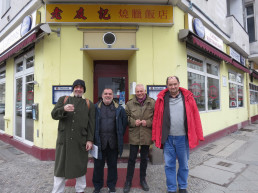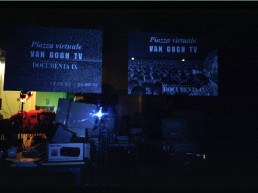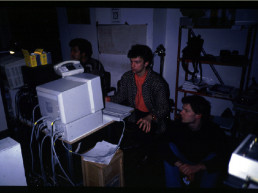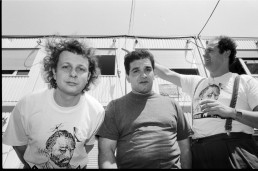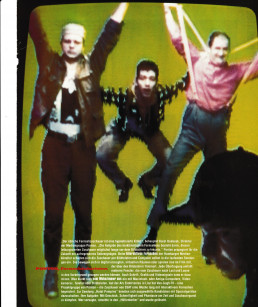Van Gogh TV (1988-1994)
In 1989 Ponton in Hamburg moved into rooms in a former machine factory in the St. Georg district near the main railway station in the street Koppel. The “Koppel66″, which still exists today, was established in 1981 on the initiative of artists as a “Haus for Kunst und Handwerk (House for Arts & Crafts) with studios and workshops. Here, a number of projects were organized by Ponton under the moniker Van Gogh TV.
The literary scholar, filmmaker and author Klaus Peter Dencker, who was Senior Director of the Hamburg Department of Culture from 1985 to 2002, wanted to support electronic media in the print media city of Hamburg, following the example of the MedienPark in Cologne, the Städel Schule in Frankfurt (which had founded an Institute for New Media in 1987 with Peter Weibel as director) and the Centre for Art and Technology (ZKM) in Karlsruhe, which was in the process of being founded. To this end, he set up the working group “Kunst und Technologie” (Art and Technology) and the media conference Interface and supported media initiatives such as Van Gogh TV with project funds. He also succeeded in getting Van Gogh TV to rent generous premises for their media lab in Koppel 66, which were originally intended for traditional artists and artisans.
The group, which had previously operated decentrally out of various cities, now had its own space for the first time; the four founders Mike Hentz, Karel Dudesek, Benjamin Heidersberger and Salvatore Vanasco now had a place where they could experiment with the equipment they had successively built up at previous projects and with their editing studio Low-Band Society that Heidersberger and Dudesek had started.
Van Gogh TV: Mike Hentz, Salvatore Vanasco, Benjamin Heidersberger and Karel Dudesek
Premises at Koppel66
Premises at Koppel66
Because Mike Hentz was at that time visiting professorships at the Hochschule für bildenden Künste (HfbK), where Salvatore Vanasco worked as an assistant, there was also a connection to the city’s art academy that was significant for the project offshoot Universcity TV. Even though direct contacts do not seem to have played a major role, the fact that the computer art pioneer Kurd Alsleben and telecommunication art expert Matthias Lehnhardt taught at the HfbK also played a role in this context – especially for the founders of the feminist artist group “Frauen und Technik” (Women and Technology), who ran the Hamburg Piazzetta at Piazza virtuale.
Ponton’s Lab quickly developed a great attraction not only for those interested in media art, but also for geeks and hackers, some of them from the German hacker association Chaos Computer Club. The video equipment and computers of all brands popular at the time, as well as access to the Internet and a BBS attracted people interested in the creative use of media technology, some of whom returned the favour of using the technology with programming or computer graphics.
The trade magazine Mac News wrote: “When you enter the headquarters of the internationally networked and operating organisation, you leave your everyday life in West Germany and begin to be amazed. Garage and basement-like rooms house an immense number of glowing monitors, Cape Kennedy-like, and computers of almost all worlds, between which people run around, pulling cables, soldering hardware, cutting videos, writing programmes, making coffee…. It looks like the futuristic world of the Max Headroom films, not quite so TV chic and sophisticated, but real – real future, which has been emerging for two years in this kind of media garage.
Many of the people who worked on the projects “Re-Publik-TV” (1989) and “Hotel Pompino” (1990) at Ars Electronica, on “Piazza virtuale” (1992) at documenta, on a new edition of Piazza virtuale in Japan (1993) in cooperation with the public television station NHK and on “Service Area” (1994) again at Ars Electronica came from this scene. Some of them were later employees in the various companies that developed out of Ponton/Van Gogh TV. The space at Koppel was used by Ponton until 1993, after which the group split up: Mike Hentz had left the group after “Piazza virtuale” in order to be able to focus on his own art. A mutual statement gives 22 Jan 1993 as the date of his departure.
In 1993, Ponton European Media Art Lab received the Media Art Prize awarded by the Centre for Art and Media (ZKM) in Karlsruhe and Siemens for Piazza Virtuale and was awarded an “Honorary Mention” at the Prix Ars Electronica.
Piazza virtuale, 1992: Benjamin Heidersberger, Salvatore Vanasco and Karel Dudesek (Foto: Ali Altschaffel, altschaffel.com)
